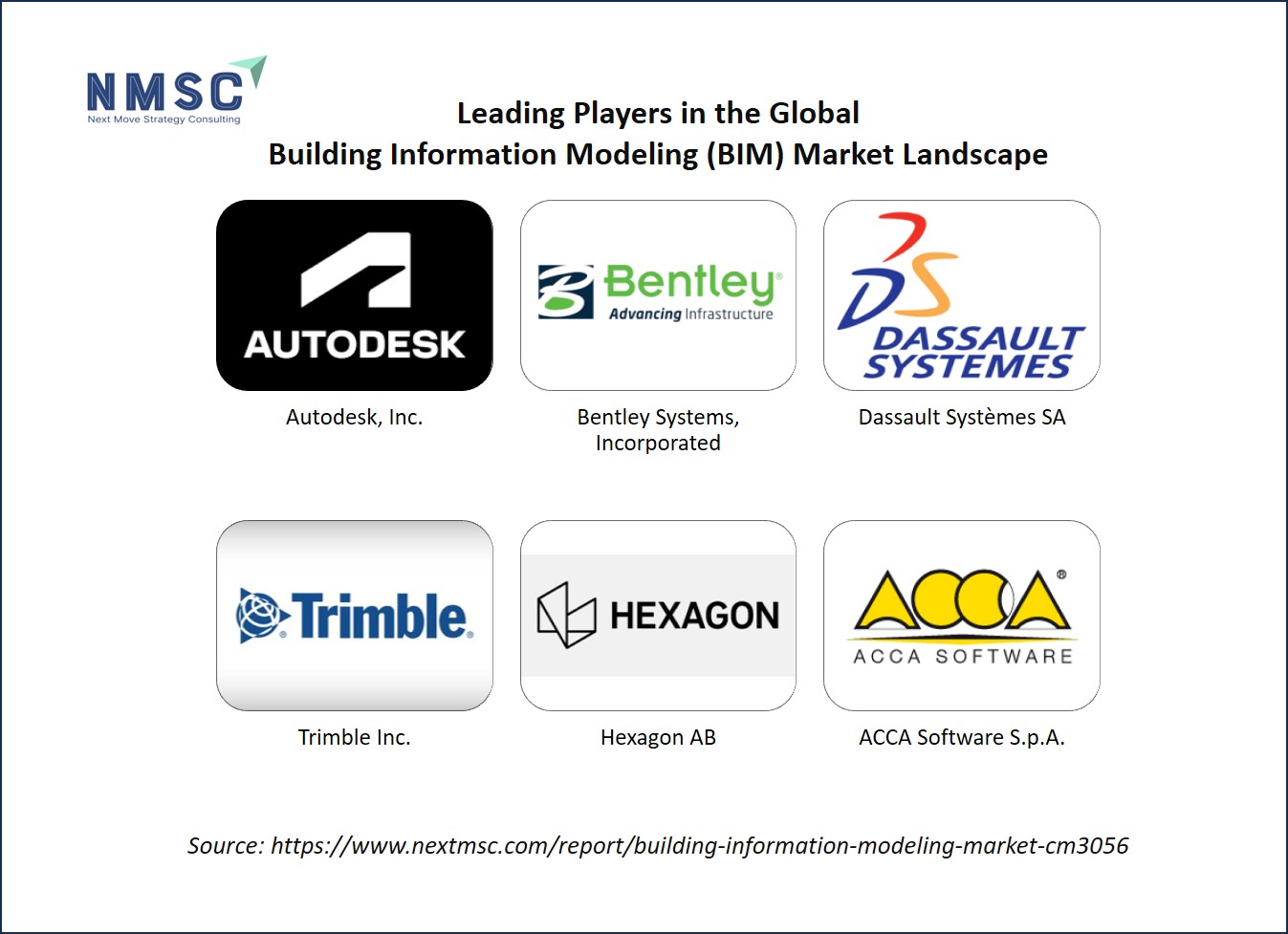How Is AI Revolutionizing the BIM Market in 2025?
Published: 2025-11-11

Imagine a world where architects converse with their designs through simple prompts, and software anticipates compliance issues before they arise. That is the promise of Building Information Modeling (BIM) today.
As a market research firm, we at Next Move Strategy Consulting (NMSC), see BIM not just as a tool, but as the backbone of smarter, more sustainable building practices. In 2025, with AI weaving into every workflow and region-specific innovations taking center stage, the BIM Market is poised for exponential growth. The sector is predicted to reach USD 21.72 billion by 2030 with a CAGR of 14.63%.
This blog dives into the latest developments, drawing from credible industry reports, to answer: What does this mean for your next project?
What Emerging Trends are Driving BIM Adoption in 2025?
Building Information Modeling has evolved from static 3D models to dynamic, intelligent ecosystems. But what specific advancements are capturing the attention of architects and engineers right now?
How does AI Act as a Design Assistant in Modern BIM Tools?
Artificial Intelligence (AI) is no longer a futuristic add-on; it is an embedded collaborator in BIM platforms. Consider Graphisoft's Archicad 29, launched as part of their Design Intelligence Strategy, which positions AI as an intelligent design assistant. This tool allows users to interact via natural language prompts for model queries and expert guidance, optimizing workflows and streamlining documentation processes.
For instance, AI Visualizer 2.0 enables model-based visualizations through text instructions, style adjustments, and precise edits, reducing manual iterations by embedding intelligence directly into the design phase.
In analytical terms, this integration enhances productivity by automating repetitive tasks. Architects can query models for compliance checks or sustainability metrics, fostering a shift from reactive to predictive design. Such capabilities align with broader market demands for efficiency, where AI-driven features in BIM software are projected to minimize errors and accelerate project timelines.
To summarize these AI trends:
-
Artificial Intelligence (AI) prompts enable conversational design interactions, making complex queries accessible.
-
Visualization tools like AI Visualizer 2.0 support rapid prototyping with editable outputs.
-
Overall, these features elevate user experience, turning BIM into a proactive partner rather than a passive repository.
This evolution underscores a key market shift: Tools that prioritize human-AI synergy are gaining traction, as evidenced by Graphisoft's focus on next-generation workflows.
Why are Integrated Workflows Essential for BIM Success?
Seamless collaboration across disciplines is the hallmark of effective BIM implementation. How do recent updates bridge the gaps between architects, engineers, and MEP specialists?
Graphisoft's ecosystem exemplifies this through MEP Designer in Archicad 29, which facilitates collaboration by automatically generating detailed documentation such as floor plans, sections, and schedules from integrated models.
Similarly, DDScad 21 supports precise design of electrical systems, surveillance networks, and fire safety measures, ensuring alignment with industry standards. These integrations eliminate silos, allowing real-time updates that propagate across the entire project model.
From a market perspective, integrated workflows reduce complexity in large-scale projects. For example, the Expo Cultural Park Greenhouse Garden—a 47,000 m² zero-energy structure—leveraged BIM strategies for optimized collaboration, enabling natural volumetric exploration while maintaining precision for analyses like sunlight exposure and views. This not only cuts costs but also enhances project outcomes.
Key benefits in bullet points
-
Automatic documentation generation speeds up MEP integration.
-
Standards-compliant designs minimize rework and delays.
-
Collaborative platforms like these foster interdisciplinary efficiency.
Integrated workflows are transforming BIM from isolated tools into unified ecosystems, directly contributing to faster market adoption.
How is the BIM Market Responding to Regional Innovations Like Autodesk's India Suite?
Global markets thrive on localization, but how is one major launch reshaping BIM accessibility in high-growth regions?
What Makes Autodesk's India-Focused BIM Suite a Game-Changer?
On June 5, 2025, Autodesk unveiled a tailored Building Information Modeling suite for India's public sector, enhancing core tools like Revit and Civil 3D with country-specific design codes, construction norms, and workflows. This suite targets engineers, architects, and policymakers, enabling faster design iterations, reduced rework, and assured regulatory compliance.
The features stand out for their practicality: Built-in support for AI, generative design, and digital transformation addresses longstanding adoption barriers in the Architecture, Engineering, Construction, and Operations (AECO) sector. By aligning tools with local standards, it streamlines processes that previously required manual adjustments, promoting sustainability through optimized resource use.
As a market research company, we view this launch as a pivotal catalyst for the BIM market. India's infrastructure ambitions—aiming for transformative growth by 2047—amplify demand for compliant, efficient tools. This suite not only boosts Autodesk's footprint in a market valued for its scale but also sets a precedent for global vendors to prioritize localization.
The result? Accelerated BIM penetration in emerging economies, potentially increasing regional adoption rates by addressing cultural and regulatory friction points. This move adds tangible value by democratizing advanced tech, empowering smaller firms to compete on sustainable projects without prohibitive customization costs.
Summarizing the impact:
-
Localized codes ensure seamless compliance, cutting project risks.
-
AI and generative features drive innovation in resource-constrained environments.
-
Broader market ripple: Encourages similar adaptations worldwide, fueling 2025 growth.
This innovation highlights how targeted solutions can unlock untapped potential, reshaping the BIM landscape one region at a time.
Key Companies in the BIM Industry
-
Autodesk, Inc.
-
Bentley Systems, Incorporated
-
Trimble Inc.
-
Dassault Systèmes SA
-
Hexagon AB
-
Procore Technologies, Inc.
-
Asite Ltd.
-
ACCA Software S.p.A.
-
Pinnacle Infotech Pvt. Ltd.
-
AVEVA Group Plc
What do Real-World BIM Projects Reveal about Market Maturity?
Theory meets practice in landmark builds, but which examples best illustrate BIM's 2025 prowess?
How did BIM Enable Zero-Energy Designs in Recent Architectural Marvels?
Sustainability is non-negotiable, so how are BIM advancements making net-zero buildings achievable?
Project Aurora, a cloud-native platform from Graphisoft, integrates context, data, and performance analytics from the earliest design stages. Using AI-assisted ideation and predictive sustainability tools, it incorporates environmental data to inform decisions, significantly reducing a project's carbon footprint.
The MJE House, spanning 1,436 m², exemplifies this: BIM optimized volumetric studies for views and sunlight, blending creativity with precision. These cases demonstrate market maturity, where BIM supports holistic decision-making. Experts like János Detre from Graphisoft emphasize early-stage analytics, noting that data-driven insights reimagine architectural possibilities.
In brief:
-
Cloud platforms like Aurora enable predictive environmental modeling.
-
Real projects showcase reduced complexity through precise simulations.
-
Expert consensus: Technology amplifies creativity while ensuring feasibility.
Ultimately, such applications affirm BIM's role in driving sustainable market growth.
|
BIM Innovation |
Key Feature |
Market Benefit |
Example Project |
|
AI Visualizer 2.0 |
Text-based edits |
Faster prototyping |
Expo Cultural Park (47,000 m²) |
|
MEP Designer |
Auto-documentation |
Reduced silos |
MJE House (1,436 m²) |
|
India BIM Suite |
Local compliance |
Regulatory ease |
Public sector infrastructure |
|
Project Aurora |
Predictive analytics |
Sustainability gains |
Zero-energy designs |
Next Steps: Actionable Takeaways for BIM Stakeholders
As the BIM market surges with AI and localized tools, what practical steps can you take today?
-
Assess Your Workflow Gaps: Audit current tools for AI integration; trial Archicad 29's prompts to identify quick wins in documentation efficiency.
-
Prioritize Localization: For global teams, adapt suites like Autodesk's India model to regional codes—start with a pilot project to measure rework reductions.
-
Invest in Training: Build internal expertise on predictive analytics via platforms like Project Aurora; aim for certification in MEP integrations within Q1 2026.
-
Collaborate Early: Form cross-disciplinary teams using cloud-native BIM to embed sustainability from day one, targeting at least 20% faster iterations.
-
Monitor Market Shifts: Subscribe to updates from Graphisoft and Autodesk for emerging features, ensuring your strategy aligns with 2025's interoperability trends.
The BIM market in 2025 is a tapestry of intelligent tools and targeted innovations, promising efficiency and sustainability for all. By leveraging these insights, you position your practice at the forefront.
What BIM challenge will you tackle first?
About the Author
 Sneha Chakraborty is a passionate SEO Executive and Content Writer with over 4 years of experience in digital marketing and content strategy. She excels in creating optimized, engaging content that enhances online visibility and audience engagement. Skilled in keyword research, analytics, and SEO tools, Sneha blends creativity with data-driven insights to deliver impactful results. Beyond her professional work, she enjoys reading, sketching, and nature photography, drawing inspiration from creativity and storytelling.
Sneha Chakraborty is a passionate SEO Executive and Content Writer with over 4 years of experience in digital marketing and content strategy. She excels in creating optimized, engaging content that enhances online visibility and audience engagement. Skilled in keyword research, analytics, and SEO tools, Sneha blends creativity with data-driven insights to deliver impactful results. Beyond her professional work, she enjoys reading, sketching, and nature photography, drawing inspiration from creativity and storytelling.
About the Reviewer
 Sanyukta Deb is an accomplished Content Writer and Digital Marketing Strategist with extensive expertise in content strategy, SEO, and audience engagement. She specializes in building strong brand visibility through data-driven campaigns and impactful, value-added researched content. With a passion for creativity and innovation, she blends strategic thinking with design and communication to craft meaningful digital experiences. Over the years, she has contributed cross-functional marketing projects, driving measurable impact and audience engagement.
Sanyukta Deb is an accomplished Content Writer and Digital Marketing Strategist with extensive expertise in content strategy, SEO, and audience engagement. She specializes in building strong brand visibility through data-driven campaigns and impactful, value-added researched content. With a passion for creativity and innovation, she blends strategic thinking with design and communication to craft meaningful digital experiences. Over the years, she has contributed cross-functional marketing projects, driving measurable impact and audience engagement.

















Add Comment